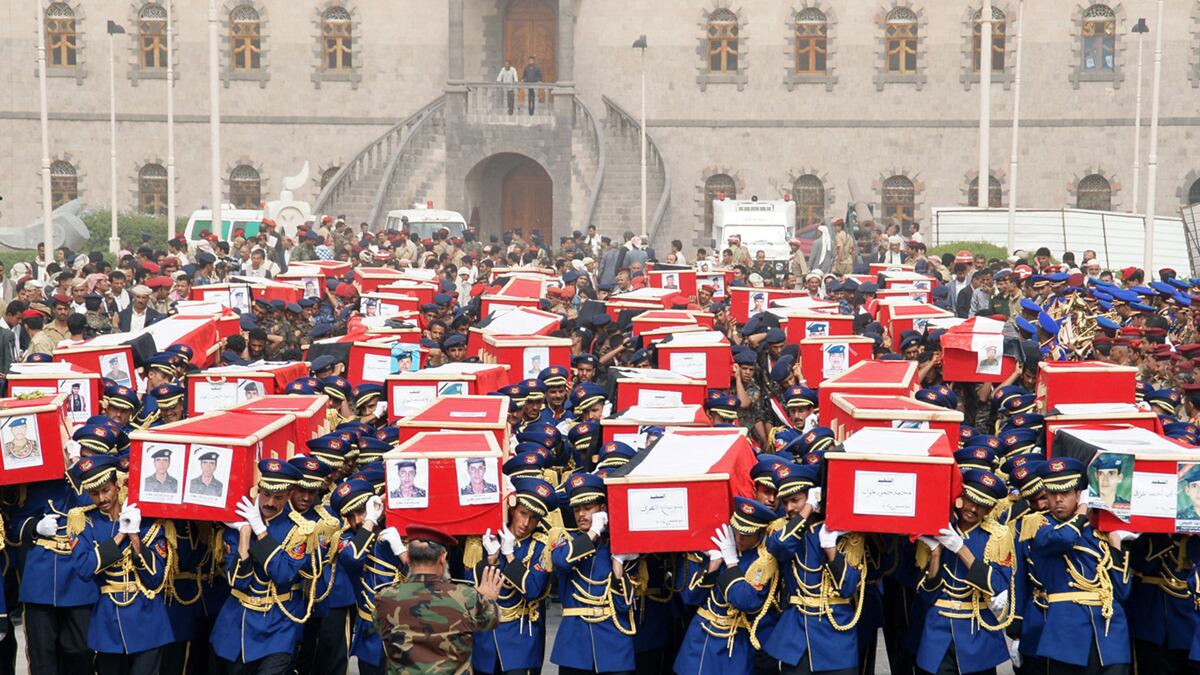Al Qaeda’s attack on Yemen’s capital, Sana, this week is a graphic demonstration that its franchise in Arabia is getting more dangerous, benefiting from the weakness of the Yemeni state. The U.S. is putting pressure on the jihadi network like never before, but al Qaeda in the Arabian Peninsula (AQAP) remains determined to strike us at home to drag us ever deeper into another quagmire in the Middle East.
The suicide bombing on Monday in Sana was the deadliest attack AQAP has ever carried out. It comes as government forces are trying to recover lost territory in southern Yemen that al Qaeda has seized since the Arab Spring came to Yemen a year ago. AQAP using a cover name, Ansar al Sharia, has set up seven so-called emirates in southern Yemen in the last year where it can recruit, train, and prepare its fighters and suicide bombers to strike at home and abroad. AQAP even controls some neighborhoods in Aden, the south’s largest city and port. President Obama is rightly trying to put the Arabian Humpty Dumpty back together again in Yemen so Yemeni forces will be able to disrupt, dismantle, and destroy AQAP. It’s an ambitious strategy.
Central to any chance of success for America in Yemen is close cooperation with Saudi Arabia, the rich big brother next door that most Yemenis resent. Any hope of rebuilding a stable central government will require massive amounts of Saudi aid—and this week the Saudis pledged $3.2 billion in new assistance. The joint U.S.-Saudi intelligence operation that foiled al Qaeda’s latest plan to blow up an airliner en route to America was a significant success in the now-12-year-old battle with al Qaeda in Yemen. AQAP also announced the May 6 death (by drone attack) of the airline-bomb plot’s operational mastermind, Shaykh Fahd al Quso al Awlaqi, one of the brains behind the 2000 attack on the USS Cole in Aden and the successor to the New Mexico-born Anwar al Awlaqi, who was also killed in a drone attack last year.
ADVERTISEMENT
These successes should not obscure the fact that AQAP remains determined to carry out attacks in the United States. Three times in three years—Christmas 2009, October 2010, and now May 2012—AQAP has tried to blow up aircraft in America’s skies. Because the bomb maker Ibrahim al Asiri, who produces these weapons, remains alive and has trained a cadre of understudies in his workshops, we can assume they will try again. AQAP brags that it has already hurt America more than once. AQAP claims al Anwar Awlaki inspired the Fort Hood attack in 2009.

AQAP has articulated an ambitious strategy. During the preparations for the trial of the Christmas 2009 bomber, Umar Farouk Abdulmuttalab, I prepared testimony to explain AQAP’s strategy to the jury. AQAP had laid it out in the video they released after his capture titled “America and the Final Trap.” Al Qaeda says it hopes that a successful mass-casualty attack on an American city from the air will provoke the U.S. to send troops to attack its bases in Yemen. AQAP wants to drag America into what it calls another “bleeding war” like Afghanistan and Iraq to sap American resources and will. Yemen, AQAP argues, will be the “final trap” that defeats America—much as the war in Afghanistan in the 1980s defeated the Soviet Union. AQAP notes that Yemen’s tough terrain and even tougher tribes have defeated foreign armies from ancient Persia to the U.K. in the 1960s.
If it can’t provoke America into the “final trap,” AQAP hopes its attacks will force the U.S. and its allies to devote more and more resources to countering its threat with expensive security measures. AQAP announced that the bombs it sent to blow up over Chicago (“Obama’s city”) in 2010 cost only $4,200 to make; countermeasures to detect them have cost billions to disburse at airports around the world. This is the strategy of a “thousand cuts” that it hopes will break America.
All this may be nothing more than the fantasies of fanatics. AQAP also hopes Israel will attack Iran to plunge the Middle East into a massive regional war that it can exploit and it hopes to someday overthrow the House of Saud to create a jihadist emirate in the Arabian Peninsula that will redistribute wealth from the ruling families of Saudi Arabia, Qatar, Kuwait, and the UAE to the poor of the region, especially in Yemen. All of this is far beyond AQAP’s throw weight. But it can continue to try. In eulogizing al Quso this week, the group promised America “the war between us is not over.”






